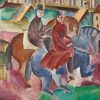Siri Derkert
"Ryttare"
Signed S.D. Executed 1916-17. Canvas 54 x 51.5 cm.
Provenance
Sothebys, Swedish Sale, Stockholm 28 maj 1998, lot no 61.
Exhibitions
Liljevalchs Konsthall, Stockholm, "Aprilutställningen", April 1921, cat no 76 (under the titel "Ryttarinnor").
Konstakademien, Stockholm, March 1976, cat no 102.
Malmö Konsthall, "Siri Derkert", 2 July - 15 August 1976, cat no 22 (under the titel "Ryttarinnor").
Nasjonalgalleriet, Oslo, "Modernismens gjennombrudd", 28 October - 18 December 1989, cat no 28.
Moderna Museet, Stockholm, 13 January - 4 March 1990, cat no 28.
Moderna Museet, Stockholm, "Siri Derkert", 28 May - 4 September 2011.
Artist
Siri Derkert was born in Stockholm in 1888 and died 1973. She is well-known as an artist, printmaker, and sculptor. She received her education at Althin's Painting School, the Royal Academy of Fine Arts in Stockholm, and at the women's civic school operated by the Fogelstad Group. Her internation studies were completed in France, Spain and Italy. She worked with all kinds of materials, primarily in the expressionist vein, but was also active in incorporating a cubist and fauvist style into her works. In 1913 she moved to Paris, where she came into contact with the visual language of cubism. From 1915 to 1916, she painted portraits and still lifes in a facetted cubist style characterized by cool and elegant colors, with lighter and darker shades creating facets that distinguished these works from her later paintings. After this period, she took a break from painting for nearly a decade. However, after this period Derkert did not touch a paintbrush for 10 years, it wasn’t until the middle of the mid-1920s when the artist started painting again, but in a new realistic style. Her three children became her models, depicted in serene portraits and lively scenes. In 1933, Derkert's life and art took a turn inward, reflecting anxiety and insecurity. Realistic forms dissolved, leaving only a few strokes to hint at the subject. The ecstatic destruction of form was replaced at the end of the decade by a renewed interest in formal issues, expressed through sculpture during the war years. In 1944, Derkert achieved breakthrough success after encountering a new world at Fogelstad, a civic school for women. She once again embraced an experimental spirit, returning to cubism and exploring new forms such as collage and a primitive and simplified graphic art, etched in metal or blasted in concrete, as seen in the Östermalmstorg subway station. In 1960, Siri Derkert became the first woman to have a solo exhibition at the Moderna Museet in Stockholm.
Read more





































